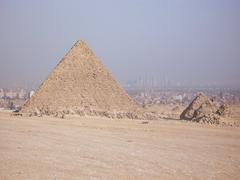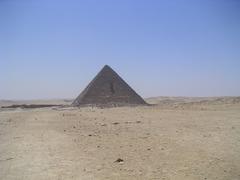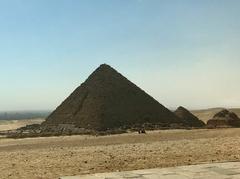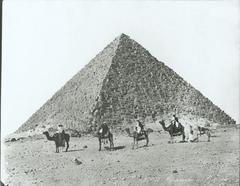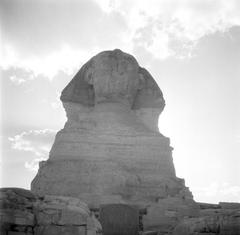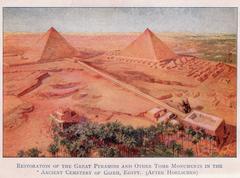
Pyramid of Menkaure: Visiting Hours, Tickets, and Historical Significance in Giza, Egypt
Date: 03/07/2025
Introduction
The Pyramid of Menkaure, the smallest but perhaps most intriguing of the three main pyramids on the Giza Plateau, offers visitors a unique combination of architectural detail, royal history, and spiritual significance. Constructed during Egypt’s Fourth Dynasty around 2510 BCE, this pyramid served as the final resting place of Pharaoh Menkaure, following the grand tradition established by his predecessors Khufu and Khafre. Despite its modest scale, the pyramid stands out for its innovative use of pink granite from Aswan, carefully designed mortuary complex, and the refined artistry that marks a turning point in ancient Egyptian funerary practices (egyptmythology.com; egypttoursportal.com).
Today, the Pyramid of Menkaure provides a quieter, more intimate experience than its larger neighbors, enhanced by recent infrastructure upgrades and a range of visitor amenities. This guide delivers comprehensive information on visiting hours, ticket options, accessibility, guided tours, travel tips, and the pyramid’s enduring cultural impact. Whether you’re a history enthusiast or a first-time traveler to Egypt, this article will help you plan an unforgettable visit to one of Giza’s most remarkable monuments.
Contents
- Introduction
- Historical Background and Menkaure’s Reign
- Construction and Architectural Features
- Visitor Information
- Visiting Hours
- Tickets and Entry
- Accessibility
- Guided Tours
- Travel Tips & Nearby Attractions
- Cultural and Artistic Significance
- The Pyramid in Modern Times
- Frequently Asked Questions (FAQs)
- Planning Your Visit
- References
Historical Background and Menkaure’s Reign
Menkaure and the Fourth Dynasty
Pharaoh Menkaure (Mykerinos) ruled during Egypt’s Fourth Dynasty (c. 2530–2510 BCE), a period considered the zenith of Old Kingdom pyramid construction (egyptmythology.com; tripsinegypt.com). He was the son of Khafre (builder of the second pyramid and the Sphinx) and grandson of Khufu (builder of the Great Pyramid). Menkaure maintained the tradition of royal pyramid construction but introduced notable changes in scale and materials, possibly reflecting evolving economic realities or religious priorities (imperialegypt.com; egypttourmagic.com).
Menkaure’s reign is often characterized by a balance of tradition and innovation. While he continued the centralized administration of his forebears, his pyramid complex was more refined and artistically ambitious, with an emphasis on quality craftsmanship and symbolic meaning (egyptmythology.com). His legacy is further enhanced by remarkable statuary—especially the triad statues of Menkaure with Hathor and other deities—emphasizing his divine role and connection to the gods.
Construction and Architectural Features
Pyramid Design and Materials
Menkaure’s pyramid originally stood about 65.5 meters (215 feet) high, with a base of 102.2 meters (335 feet) on each side and a steep slope of approximately 51°20′ (travelpander.com; ancientpedia.com). The lower sixteen courses were built from massive pink granite blocks quarried in Aswan—over 800 kilometers away—while the upper courses were of local limestone, once clad in polished white Tura limestone (egyptatours.com).
The pyramid’s interior is more complex than its predecessors. The descending passage leads to an antechamber, a granite-lined burial chamber (once housing a magnificent sarcophagus, lost at sea in the 19th century), and additional rooms with niches—possibly for ritual objects (egypttoursportal.com; globalhighlights.com).
Mortuary Complex and Queen’s Pyramids
To the east lies an elaborate mortuary temple, originally finished in granite and mudbrick, reflecting evolving burial practices and the importance of funerary cults (travelpander.com). A causeway connects the mortuary temple to the valley temple near the ancient Nile. Three subsidiary (queen’s) pyramids and boat pits flank the main structure, serving as tombs for royal family members and underscoring the pyramid’s ceremonial significance (egypttoursportal.com).
Visitor Information
Visiting Hours
- Standard Hours: The Giza Plateau—including the Pyramid of Menkaure—is open daily from 8:00 AM to 5:00 PM. Hours may be extended in summer.
- Interior Access: Follows the same hours, but with limited daily visitor capacity. Arrive early for best access (Everyday Monkey).
Tickets and Entry
- General Admission (2025): 700 EGP for adults, 350 EGP for students (with valid ID)
- Menkaure Interior Ticket: 280 EGP (limited availability)
- Where to Buy: At the main entrance or online via official platforms. Purchase both plateau and interior tickets early to avoid sellouts (Kosupa Travel).
Accessibility
- Site Terrain: Improved pathways and signage, but expect sandy, uneven ground—sturdy shoes recommended. The pyramid’s interior is not wheelchair accessible due to steep, narrow passages.
- Visitor Assistance: Security and staff are available on-site. Some guided tours offer tailored routes for visitors with mobility challenges (Earth Trekkers).
Guided Tours
- On-Site and Pre-Booked: Certified Egyptologist guides are available for hire at the visitor center or can be booked in advance.
- Tour Options: Range from private, in-depth explorations to group tours covering all major Giza monuments (Wanderlust Around the Globe).
Travel Tips & Nearby Attractions
- Best Time to Visit: Early mornings or late afternoons for fewer crowds and better light (Time Travel Turtle).
- Amenities: Modern restrooms, shaded rest areas, and food outlets are available. Carry water, use sun protection, and bring cash for purchases (Infohostels).
- Nearby Attractions: Grand Egyptian Museum (GEM), Solar Boat Museum, Great Sphinx, and nightly Sound and Light Show (Egypt Immigration; Egyptian Streets).
Cultural and Artistic Significance
Menkaure’s pyramid marks a pivotal moment in Egyptian funerary architecture—blending traditional grandeur with refined artistry. The use of rare granite, complex interior chambers, and the mortuary complex’s layout represent evolving beliefs about the afterlife, the king’s divinity, and the importance of family unity (egyptmythology.com). The famous triad statues and reliefs discovered in the mortuary temple underscore the pharaoh’s role as both a political and spiritual leader, acting as the bridge between gods and mortals (autodidactprofessor.com).
The Pyramid in Modern Times
Over the centuries, Menkaure’s pyramid has survived periods of neglect, partial demolition, and the loss of key artifacts. The 19th-century salvage of its basalt sarcophagus, which was subsequently lost at sea, exemplifies the challenges of preserving Egypt’s ancient heritage (imperialegypt.com). Today, the pyramid is a UNESCO World Heritage Site and benefits from ongoing conservation efforts and upgraded visitor infrastructure, ensuring its stories endure for generations (egypt-uncovered.com).
Frequently Asked Questions (FAQs)
What are the Pyramid of Menkaure visiting hours?
Open daily from 8:00 AM to 5:00 PM, with possible extensions in summer.
How much are tickets for the Pyramid of Menkaure?
700 EGP for adults, 350 EGP for students (Giza Plateau entry); 280 EGP for interior pyramid access (Kosupa Travel).
Is the pyramid accessible for people with disabilities?
The site has improved paths but the interior is not wheelchair accessible.
Can I buy tickets online?
Yes, tickets can be bought online and at the entrance.
Are guided tours available?
Yes, certified guides are available at the visitor center or via pre-booking.
What is the best time to visit?
Early mornings on weekdays are quietest; avoid weekends and holidays for the best experience.
Planning Your Visit: Tips for a Memorable Experience
- Arrive Early: Beat the crowds and heat by visiting at opening.
- Buy All Tickets at Entry: Secure interior access tickets promptly.
- Dress for Comfort: Sturdy shoes, light clothing, and sun protection recommended.
- Stay Hydrated: Bring water, especially in hot months.
- Negotiate with Vendors: If opting for camel or horse rides, agree on prices beforehand.
- App Downloads: The Audiala app offers guided audio tours, real-time updates, and planning resources.
Visuals and Media
Image Alt Text: Pyramid of Menkaure at Giza Plateau, Egypt—visitor information and historical site.
- Access official virtual tours and interactive maps to enhance your planning.
Conclusion
The Pyramid of Menkaure stands as a testament to the sophistication and adaptability of ancient Egyptian civilization. Its scale and artistry reflect a nuanced evolution in royal burial practices, emphasizing quality and symbolism over sheer size. Enhanced infrastructure and visitor amenities now make exploring this hidden gem both comfortable and enriching. By planning ahead and leveraging resources like the Audiala app, you can experience the full majesty of this remarkable monument and its surrounding Giza historical sites.
References
- Exploring the Pyramid of Menkaure: The Forgotten Pharaoh
- Menkaure Pyramid Historical Guide
- Menkaure Pyramid Visitor Information
- The Pyramid of Menkaure: The Smallest Wonder of Giza
- 3 Great Pyramids of Giza
- The Pyramid of Menkaure - Complete Guide
- Inside the Pyramids of Giza: My Visit to the Burial Chamber of Menkaure’s Pyramid
- Visiting the Great Pyramids of Giza
- The Spiritual Importance of the Egyptian Pyramid Complex
- The Pyramid of Menkaure: A Study of Royal Burials
- Menkaure: The Compassionate Pharaoh of the Fourth Dynasty
- The Pyramid of Menkaure - Smallest Wonder of Giza
- Egyptian Ministry of Tourism – Official Site
- Virtual Tour of Giza Pyramids
